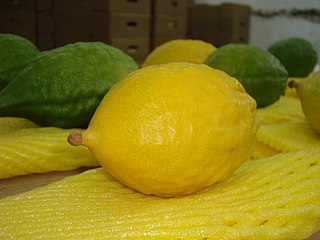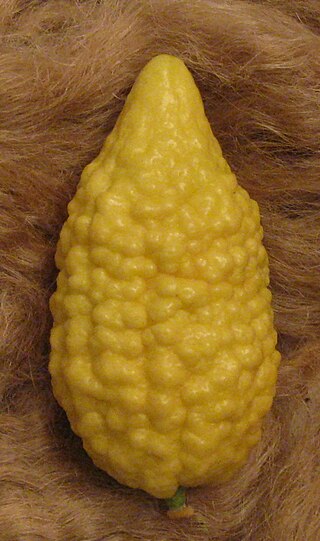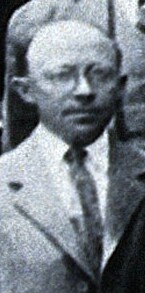
Citrus is a genus of flowering trees and shrubs in the rue family, Rutaceae. Plants in the genus produce citrus fruits, including crops such as oranges, lemons, grapefruits, pomelos, and limes. The genus Citrus is native to South Asia, East Asia, Southeast Asia, Melanesia, and Australia. Various citrus species have been used and domesticated by indigenous cultures in these areas since ancient times. From there its cultivation spread into Micronesia and Polynesia by the Austronesian expansion ; and to the Middle East and the Mediterranean via the incense trade route, and onwards to Europe and the Americas.

Levi Eshkol, born Levi Yitzhak Shkolnik, was an Israeli statesman who served as the third Prime Minister of Israel from 1963 until his death from a heart attack in 1969. A founder of the Israeli Labor Party, he served in numerous senior roles, including Minister of Defense (1963–1967) and Minister of Finance (1952–1963).

Etrog is the yellow citron or Citrus medica used by Jews during the week-long holiday of Sukkot as one of the four species. Together with the lulav, hadass, and aravah, the etrog is taken in hand and held or waved during specific portions of the holiday prayers. Special care is often given to selecting an etrog for the performance of the Sukkot holiday rituals.

The citron, historically cedrate, is a large fragrant citrus fruit with a thick rind. It is said to resemble a 'huge, rough lemon'. It is one of the original citrus fruits from which all other citrus types developed through natural hybrid speciation or artificial hybridization. Though citron cultivars take on a wide variety of physical forms, they are all closely related genetically. It is used in Asian and Mediterranean cuisine, traditional medicines, perfume, and religious rituals and offerings. Hybrids of citrons with other citrus are commercially more prominent, notably lemons and many limes.

Citrus medica var. sarcodactylis, or the fingered citron, is an unusually-shaped citron variety whose fruit is segmented into finger-like sections, resembling those seen on representations of the Buddha. It is called Buddha's hand in many languages including English, Chinese, Japanese, Korean, Vietnamese, and French.
Eliezer David Jaffe was an Israeli professor of social work specializing in philanthropy and non-profit management. He was Professor Emeritus at The Hebrew University's Paul Baerwald School of Social Work and Social Welfare.

Sweet lemon and sweet lime refer to groups of citrus hybrids that contain low acid pulp and juice. They are hybrids often similar to non-sweet lemons or limes, but with less citron parentage. Sweet limes and lemons are not sharply separated:
The sweet lime, Citrus limettioides Tan., is often confused with the sweet lemon, C. limetta Tan., which, in certain areas, is referred to as "sweet lime". In some of the literature, it is impossible to tell which fruit is under discussion.

Agricultural research in Israel is based on close cooperation and interaction between scientists, consultants, farmers and agriculture-related industries. Israel's semi-arid to arid climate and shortage of high quality water are major constraints facing Israeli agriculture. Through extensive greenhouses production, vegetables, fruits and flowers are grown for export to the European markets during the winter off-season.

The ponderosa lemon is a citrus hybrid of a pomelo and a citron. It is not the same as the 'Yuma Ponderosa' lemon-pomelo hybrid used as citrus rootstock.

Chlorophyllase is an essential enzyme in chlorophyll metabolism. It is a membrane proteins commonly known as chlase (EC 3.1.1.14, CLH) with systematic name chlorophyll chlorophyllidohydrolase. It catalyzes the reaction

The Greek citron variety of Citrus medica was botanically classified by Adolf Engler as the "variety etrog". This refers to its major use for the Jewish ritual etrog during Sukkot.

The Diamante citron is a variety of citron named after the town of Diamante, located in the province of Cosenza, Calabria, on the south-western coast of Italy, which is its most known cultivation point. This is why this variety is sometimes called the "Calabria Esrog". "Esrog" is the Ashkenazi Hebrew name for citron.

The balady citron is a variety of citron, or etrog, grown in Israel and Palestine, mostly for Jewish ritual purposes. Not native to the region, it was imported around 500 or 300 BCE by either Jewish or Greek settlers. Initially not widely grown, it was promoted and popularized in the 1870s by Rabbi Chaim Elozor Wax.

The Yemenite citron is a variety of citron, usually containing no juice vesicles in its fruit's segments. The bearing tree and the mature fruit's size are somewhat larger than the trees and fruit of other varieties of citron.

The Moroccan citron is a true citron variety native to Assads, Morocco, which is still today its main center of cultivation.

Moshe (Max) W. Prausnitz was an Israeli archaeologist who specialized in the prehistory field.

Israel Jacob Kligler was a microbiologist, Zionist and humanist. Kligler was born in the Austro-Hungarian Empire, educated in the United States and spent most of his career in Mandatory Palestine, but died before the creation of the State of Israel. He was one of the first four professors of the Hebrew University and the founder of Department of Hygiene and Bacteriology of the university, which he headed until his death in 1944. Kligler was one of the pioneers of modern medical research in Mandatory Palestine, studying as varied a field as Bacteriology, Parasitology, Virology, Nutrition, Epidemiology and Public Health. He developed the Kligler Iron Agar medium for the isolation and identification of intestinal bacteria, which is still in use today.

Citrus taxonomy refers to the botanical classification of the species, varieties, cultivars, and graft hybrids within the genus Citrus and related genera, found in cultivation and in the wild.

Shlomo Margel is a Professor of Chemistry at Bar Ilan University specializing in polymers, biopolymers, functional thin films, encapsulation, surface chemistry, nanotechnology, nanobiotechnology and agro-nanotechnology.

Elisabeth Goldschmidt was a German-born Israeli geneticist who founded the genetics program at the Hebrew University of Jerusalem. She has been described as "the founding mother of the field of genetics in Israel".



















